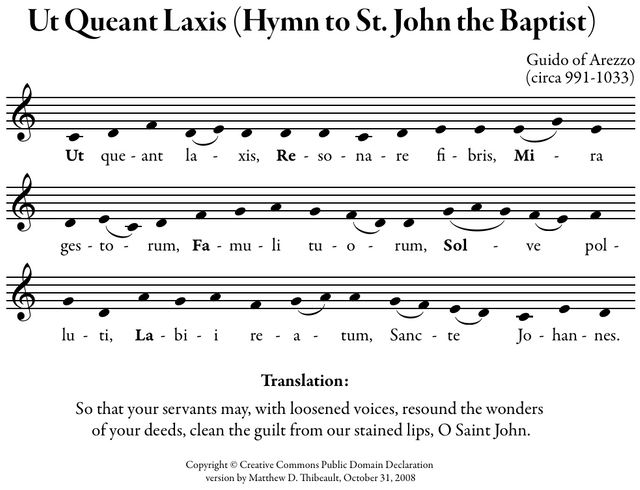Devil's Advocate: Solfège - Which is more Ideal, Fixed or Movable?
Hello everyone! I have studied music for over a decade at this point, and everyone within the professional world seems to have a different opinion in regards to terminology. What seems to be most frequently debated (in my life at least) is whether movable Solfège or fixed Solfège is better. In this article, I will present both arguments. First, I will summarize this new series which I have decided to make:
 Image Source: Pixabay.com
Image Source: Pixabay.com
 Image Source: Pixabay.com
Image Source: Pixabay.comThe Devil's Advocate
I decided to make this series in order to further develop my own ability to argue the views of the opposition. It is an important skill to have, and, if done correctly, will leave me questioning my own views until they are reaffirmed or changed. The point of this series is to try to present both arguments in an unbiased and convincing way to the point that my true view is not known.
The Origins of Solfège
Several years ago, I wrote this article which discussed the origins of solfeggio. However, for all intents and purposes, I am going to briefly summarize the origins for this article.
Solfège originates from an 11th century hymn called Ut Queant Laxis. The syllables originate from the first syllables of the beginning of each phrase in the hymn as it ascends from scale degree 1 to scale degree 6. Here's a visual representation from the wikipedia page:

The first syllable was later changed from Ut to Do in order to utilize a more open syllable, and the initials of Sāncte Iōhannēs from the hymn were used to represent scale degree 7 (which hadn't been discovered in the time of the hymn). In modern times, many people now refer to scale degree 7 as Ti (most likely to avoid starting with the same syllable as Sol, and avoid confusion with the note name C). Here's a depiction of the modern syllables.
Do
Re
Mi
Fa
Sol
La
Si (Now called Ti in some instances)
Movable Do
Now, the debate begins. Movable Do is centered around the idea that the syllables are representations of their respective scale degrees. This means that when the tonal center changes, so too do the notes represented by Solfège. To provide an example:
C Major:
C - Do
D - Re
E - Mi
F - Fa
G - Sol
A - La
B - Si (or Ti)
Eb Major:
Eb - Do
F - Re
G - Mi
Ab - Fa
Bb - Sol
C - La
D - Si (or Ti)
In moveable Do, each of the chromatic alterations of each of the scale degrees has a seperate name. So:
1 - Do
1# - Di
2 - Re
2# - Ri
3 - Mi
4 - Fa
4# - Fi
5 - Sol
5# - Si
6 - La
6# Li
7 - Ti (in this instance Si would cause a lot of confusion)
and
1 - Do
7 - Ti
7b - Te
6 - La
6b - Le
5 - Sol
5b - Se
4 - Fa
3 - Mi
3b - Me
2 - Re
2b - Ra
This means that every different note has a different syllable.
Argument
Someone who supports movable Do might argue that Movable Do provides a beneficial mindset because it forces the musician to think in terms of scale degrees. Movable Do makes transposing a lot easier (because the syllables translate just as easily as scale degrees). They'd argue that this also advances thinking in terms of pitch because you are not just thinking of a note name, but how that name interacts with the other notes due to the representation of scale degrees. For example, Ti resolving up to Do (when functioning as a leading tone). They might also argue that fixed Do is confusing in its lack of terms for chromatic variants.
Fixed Do
Fixed Do is centered around the idea that each of the syllables is a representation of a specific note. This means that no matter the tonal center, the syllables always represent:
C (b)(#) - Do
D (b)(#) - Re
E (b)(#) - Mi
F (b)(#) - Fa
G (b)(#) - Sol
A (b)(#) - La
B (b)(#) - Si
Argument
Someone who supports fixed Do might argue that changing the syllables along with the tonal center creates too much confusion in instances of high amounts of modulation. They would also argue that a majority of the countries of the world utilize fixed Do, and, Fixed Do creates a credible solution to language barriers by providing common names for all of the different notes of the scale. They might argue that a lack of names for chromatic variants makes Solfège much simpler and easier to grasp.
Sources
Conclusion
Thanks for reading this! Let me know your opinions in the comments! See you tomorrow!

(Note) In order to encourage meaningful feedback on the platform, I will check comment trails of users who leave superficial comments (ie "Awesome post," or "Upvoted.") and will mute any users who exhibit a pattern of leaving "spammy" comments.
Resteemed, your post will appear in the next curation with a SBD share for you!
Your post has been supported and upvoted from the Classical Music community on Steemit as it appears to be of interest to our community. We also support jazz and folk music posts!
If you enjoy our support of the #classical-music community, please consider a small upvote to help grow the support account!
You can find details about us below.
The classical music community at #classical-music and Discord. Follow our community accounts @classical-music and @classical-radio or follow our curation trail (classical-radio) at SteemAuto!
Delegation links: 10SP, 25SP, 50SP, 75SP, 100SP, 150SP, 200SP, 250SP, 500SP, 1000SP
Congratulations @cmp2020! You have completed the following achievement on the Steem blockchain and have been rewarded with new badge(s) :
You can view your badges on your Steem Board and compare to others on the Steem Ranking
If you no longer want to receive notifications, reply to this comment with the word
STOPVote for @Steemitboard as a witness to get one more award and increased upvotes!